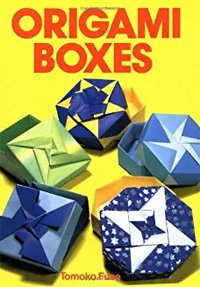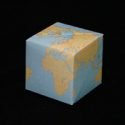Origami Boxes
by Tomoko Fuse

Origami Boxes by Tomoko Fuse: if you’re an origami box enthusiasts, this book is for you. For only $10, you will get the instructions to make over 15 different boxes – and that’s just the lids. There’s more if you count the base of the box.
Generally speaking, the boxes are easy to make. All the folds are either mountain folds or valley folds with no sinks, reverse folds, nor crimps; but there are a few pleats near the end of the book.
The book starts with origami boxes which require 2 sheets of paper to make (plus 2 more sheets for the base of the box). The basic fold gives you a lid with two triangles of color (right). A minor modification allows the white part of the paper to be visible as two slashes of white (left). Very elegant design.
The next set of boxes use 4 sheets of paper for the lids and 4 sheets for the base. You can use all different colors or two contrasting colors as shown. These are called bow knot (far left), lightening (second from left), wheel (third from left), and lozenge (right). These are all folded the same way, but connected together in different ways to achieve the different designs.
The next set of boxes have pin wheel designs on the lids. Again, the units are folded the same way but the different patterns are obtained by connecting the units in different ways. There are 3 patterns in this set, plus minor changes to give more variations.
The book includes a triangular box (small, medium, and large), two hexagonal boxes, and two octagonal boxes. The units are easy to fold but it is a little more challenging to assemble the pieces together.

There’s a few things you should know about this book:
First, all the boxes (the lids) are made with 2, 4 or 6 sheets of square paper (need another 2, 4, or 6 sheets for the base of box). Each sheet is folded into a “unit” or “module” and then the units are joined together without glue or tape. This kind of origami is called modular origami and is becoming more and more popular.
Second, the units are all very easy to fold except the last part which converts the flat sheet into a 3 dimensional piece. This transformation is not hard if you think about how parts of the paper can be lifted to form the walls of the box.
Start with the easier models at the beginning of the book and then progress to the harder models at the end of the book. Once you’ve figured out how to do a few, the others will be easy.
The instructions to make the boxes are almost exclusively based on diagrams with dashed & dotted lines and arrows. The diagrams are black & white, but the book does show the finished boxes in color photos.




















